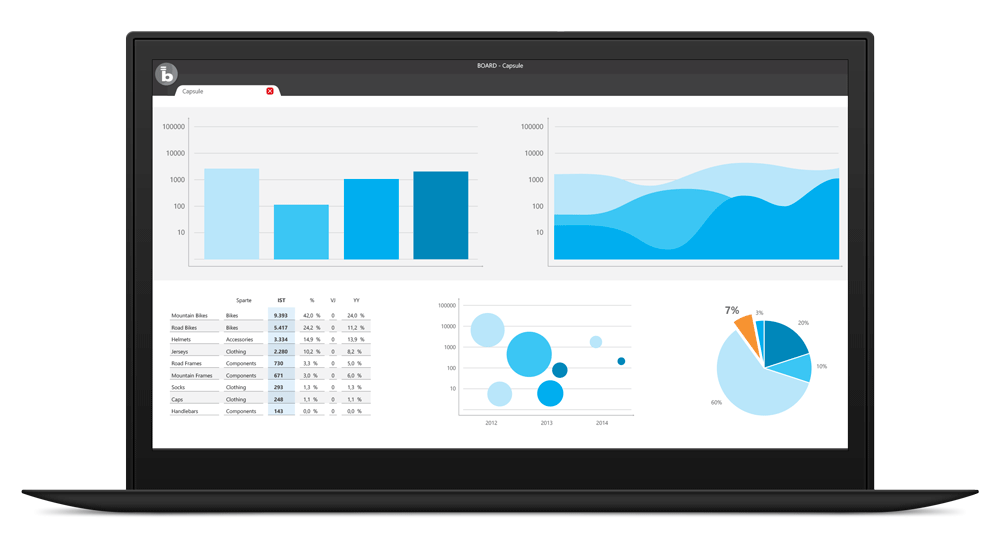From Data to Decisions: Maximizing BSC (Balanced score card) Effectiveness with Business Intelligence

In today’s fast-paced business environment, organisations are constantly seeking ways to gain a competitive edge and drive success. One powerful approach is the integration of business intelligence (BI) with the balanced scorecard (BSC). This combination allows companies to extract valuable insights from their data, identify trends, and make data-driven decisions that align with their strategic goals. By leveraging BI within the BSC framework, businesses can effectively track key performance indicators, gain a deeper understanding of the factors influencing those metrics, and ultimately drive continuous improvement. In this article, we will delve into the benefits of integrating BI with the balanced scorecard, highlighting
Understanding the Balanced Scorecard (BSC)
The Balanced Scorecard (BSC) is a tool for strategic management, offering organisations a broad perspective on performance. It looks beyond finances to includes
1)Assesses customer satisfaction.
- Customer Surveys and Feedback
Regularly collecting feedback from customers through surveys, interviews, focus groups, or other means to gauge their satisfaction levels with products, services, and overall experience.
- Nett Promoter Score (NPS)
NPS measures the likelihood of customers to recommend a company’s products or services to others. It provides a simple metric to track customer loyalty and satisfaction.
- Customer Retention Rate
Tracking the percentage of customers retained over a specific period helps gauge how satisfied customers are with the company’s offerings. High retention rates typically indicate high satisfaction levels.
- Customer Complaints and Resolutions
Monitoring the number of complaints received from customers and how effectively they are resolved can indicate overall satisfaction levels. A decreasing trend in complaints and swift resolutions suggest improving satisfaction.
- Customer Lifetime Value (CLV)
CLV assesses the total value a customer brings to the company over their entire relationship. Satisfied customers tend to have higher CLVs due to repeat purchases and loyalty.
- Market Share and Customer Acquisition
Analysing changes in market share and the effectiveness of customer acquisition strategies can indirectly reflect customer satisfaction. Satisfied customers are more likely to remain loyal and attract new customers through positive word-of-mouth.
- Quality and Product/Service Performance Metrics
Monitoring metrics related to product or service quality, such as defect rates, on-time delivery, or service uptime, can influence customer satisfaction levels.
- Brand Perception and Reputation
Assessing how customers perceive the brand and its reputation in the market can provide insights into overall satisfaction levels. Positive brand sentiment often correlates with high customer satisfaction.
- Benchmarking Against Competitors
Comparing customer satisfaction metrics against industry benchmarks or competitors’ performance can provide context and identify areas for improvement.
- Customer Segmentation Analysis
Analysing satisfaction levels among different customer segments helps identify specific strengths and weaknesses in serving various customer groups.
2)Monitors internal processes.
- Quality
Measure the quality of products or services delivered by the organization. This can include metrics such as defect rates, customer satisfaction scores, or compliance with quality standards.
- Efficiency
Assess the efficiency of internal processes in terms of resource utilisation, cycle times, and productivity. Key metrics may include cost per unit, throughput times, or resource utilisation rates.
- Flexibility
Evaluate the organisation’s ability to adapt and respond to changes in the business environment or customer needs. Metrics might focus on agility, time to market, or the ability to customise products or services.
- Innovation
Monitor the organisation’s innovation capabilities, including the development of new products, processes, or technologies. Metrics could include the number of new product launches, patents filed, or investments in research and development.
- Compliance
Ensure that internal processes adhere to relevant laws, regulations, and industry standards. Metrics may include audit findings, regulatory compliance scores, or the number of reported incidents.
- Employee Satisfaction and Engagement
Assess the satisfaction and engagement levels of employees involved in internal processes. This can be measured through surveys, turnover rates, or performance reviews.
- Supply Chain Performance
Evaluate the performance of the organisation’s supply chain processes, including supplier relationships, inventory management, and logistics. Metrics might include supplier delivery times, inventory turnover ratios, or supply chain costs.
- Environmental Impact
Measure the environmental impact of internal processes, including energy consumption, waste generation, and carbon emissions. Metrics may include energy efficiency improvements, waste reduction targets, or environmental certifications.
- Risk Management
Assess the organisation’s ability to identify, assess, and mitigate risks associated with internal processes. Metrics might focus on risk exposure, incident response times, or the effectiveness of risk mitigation strategies.
- Customer Feedback
Gather feedback from customers regarding their experiences with the organisation’s products or services. Metrics could include the Nett Promoter Score (NPS), customer complaints, or customer retention rates.
3)Monitors learning and growth.
- Employee Training and Development
Monitor the extent to which employees are receiving relevant training and development opportunities to enhance their skills and capabilities.
- Knowledge Management:
Assess the effectiveness of knowledge sharing and management practices within the organization. This could include metrics on knowledge transfer, retention, and utilisation.
- Innovation Metrics
Track the organisation’s investment in research and development, as well as the effectiveness of innovation processes. This may involve measuring the number of new products or services introduced, patents filed, or successful innovation initiatives.
- Employee Engagement and Satisfaction
Measure employee satisfaction and engagement levels through surveys or feedback mechanisms. High levels of employee engagement are often indicative of a positive learning culture.
- Adaptability and Flexibility
Evaluate the organisation’s ability to adapt to changing market conditions, technologies, and customer preferences. This could involve monitoring the speed and effectiveness of decision-making processes or the implementation of agile methodologies.
- Leadership Development
Assess the effectiveness of leadership development programmes and initiatives. This may include tracking the promotion rates of internal candidates, leadership competency assessments, or 360-degree feedback.
- Learning Culture
Evaluate the organisation’s culture regarding learning and continuous improvement. This could involve assessing the frequency of knowledge-sharing sessions, the use of performance feedback mechanisms, or the presence of learning communities.
- Technology Infrastructure
Monitor the adequacy and effectiveness of the organisation’s technology infrastructure to support learning and growth initiatives. This may include metrics related to the availability of learning management systems, access to online resources, or the integration of new technologies for training purposes.
- Quality of Feedback Loops
Assess the quality and effectiveness of feedback loops within the organization. This involves evaluating how well feedback is collected, analysed, and acted upon to drive learning and improvement.
- Benchmarking and Best Practices
Compare the organisation’s learning and growth performance against industry benchmarks and best practices. This can provide insights into areas where the organisation excels and areas that require improvement.
4). Finance perspective.
- Revenue Growth
This measures the increase in revenue over a specific period. It reflects the organisation’s ability to generate more income from its products or services.
- Profitability
Monitoring profitability involves assessing the organisation’s ability to generate profits relative to its expenses. Key metrics here include gross profit margin, operating profit margin, and nett profit margin.
- Cost Control
Evaluating cost control measures the organisation’s efficiency in managing expenses. It involves monitoring various costs, such as production costs, operating expenses, and overhead costs.
- Return on Investment (ROI):
ROI measures the profitability of an investment relative to its cost. It helps assess the effectiveness of resource allocation and capital investment decisions.
- Cash Flow
Monitoring cash flow involves tracking the movement of cash in and out of the organization. Positive cash flow ensures the organisation’s ability to meet its financial obligations and invest in growth opportunities.
- Asset Utilisation
This criterion assesses how effectively the organisation utilises its assets to generate revenue. It includes metrics like asset turnover ratio and inventory turnover ratio.
- Financial Stability
Evaluating financial stability involves assessing the organisation’s ability to meet its long-term financial obligations. Key indicators include the debt-to-equity ratio, interest coverage ratio, and liquidity ratios.
- Budget Adherence
This criterion measures the organisation’s ability to adhere to its budgetary allocations. It involves comparing actual financial performance against budgeted targets.
- Market Share
Monitoring market share helps assess the organisation’s competitive position within its industry. It involves tracking the percentage of total market sales or revenue captured by the organisation.
- Risk Management
Evaluating risk management involves identifying and mitigating financial risks that could impact the organisation’s performance. It includes assessing factors such as credit risk, market risk, and operational risk.
A fresh angle on the BSC is its role in aligning activities with strategic goals. Rather than focusing solely on short-term financial outcomes, it promotes a holistic approach to performance assessment. Another interesting aspect is its adaptability across industries and organizations. By using relevant key performance indicators (KPIs), businesses can customise their scorecards to focus on what matters most in their contexts, aiding deeper insight into priorities and targeted improvements.
In summary, understanding the Balanced Scorecard means appreciating its comprehensive nature and how it can improve decision-making across different organisational levels.
Importance of Business Intelligence in BSC
Business Intelligence in a Balanced Scorecard Framework
- Provides valuable insights and data-driven decisions.
• Enables the collection, analysis, and interpretation of large data volumes.
• Measures KPIs and evaluates the overall business strategy.
• Tracks operational efficiency, customer satisfaction, and financial performance.
• Allows proactive decision-making by identifying trends and patterns in data.
• aligns strategic objectives with factual insights for a holistic view of business performance.
• Fosters a culture of continuous improvement by identifying areas for optimisation.
• leverages relevant data to adapt to changing market conditions and foster innovation.
Leveraging data for performance measurement
Using data to measure performance is essential for businesses striving to remain competitive in today’s fast-paced market. The balanced scorecard method allows organisations to measure performance across different areas like finances, customer satisfaction, internal processes, and growth. This comprehensive approach helps companies pinpoint areas needing improvement and make informed decisions based on data.
Business intelligence (BI) tools are vital for leveraging data in performance measurement. They enable organisations to gather, analyse, and visualise large amounts of data from various sources, providing valuable insights into key performance indicators (KPIs). With BI, businesses can track progress, spot trends, predict future outcomes, and take strategic actions to enhance performance.
In today’s business landscape, using data for performance measurement isn’t just beneficial—it’s necessary. By adopting the balanced scorecard method and utilising powerful BI tools to monitor KPIs across different aspects of their operations, organisations can gain a competitive advantage by making informed decisions that positively impact their overall performance.
Integrating Business Intelligence Tools with BSC
By integrating business intelligence tools with the Balanced Scorecard (BSC), organisations can gain valuable insights into their operations and make informed decisions. The combination of BSC and business intelligence tools allows for a holistic view of key performance indicators, enabling businesses to analyse data from multiple sources and identify trends with greater accuracy. This integration provides a comprehensive understanding of both financial and non-financial metrics, leading to improved decision-making processes.
One of the key benefits of integrating business intelligence tools with BSC is the ability to track progress in real-time. With access to up-to-date data from various departments, organisations can make timely adjustments to their strategies and objectives, ensuring that they stay aligned with their overall goals. Additionally, by leveraging the advanced analytics offered by business intelligence tools, businesses can uncover hidden patterns and correlations within the BSC framework, ultimately leading to more proactive decision making.
The integration also empowers users to create customised reports and dashboards that provide actionable insights at a glance. This not only streamlines the process of monitoring KPIs but also enhances transparency and accountability across different levels of the organization. Ultimately, integrating business intelligence tools with BSC enables businesses to adapt quickly to changing market dynamics and drive continuous improvement in their performance management practices.
Challenges and Solutions for Maximising BSC Effectiveness
Maximising Balanced Scorecard (BSC) Effectiveness
Challenges:
• Difficulty aligning BSC metrics with organisational goals and strategies.
• Risk of information overload due to tracking too many metrics.
Solutions:
• Prioritise strategic alignment when selecting BSC metrics.
• Implement technology solutions like dashboard tools for real-time tracking and visualisation of performance metrics.


















